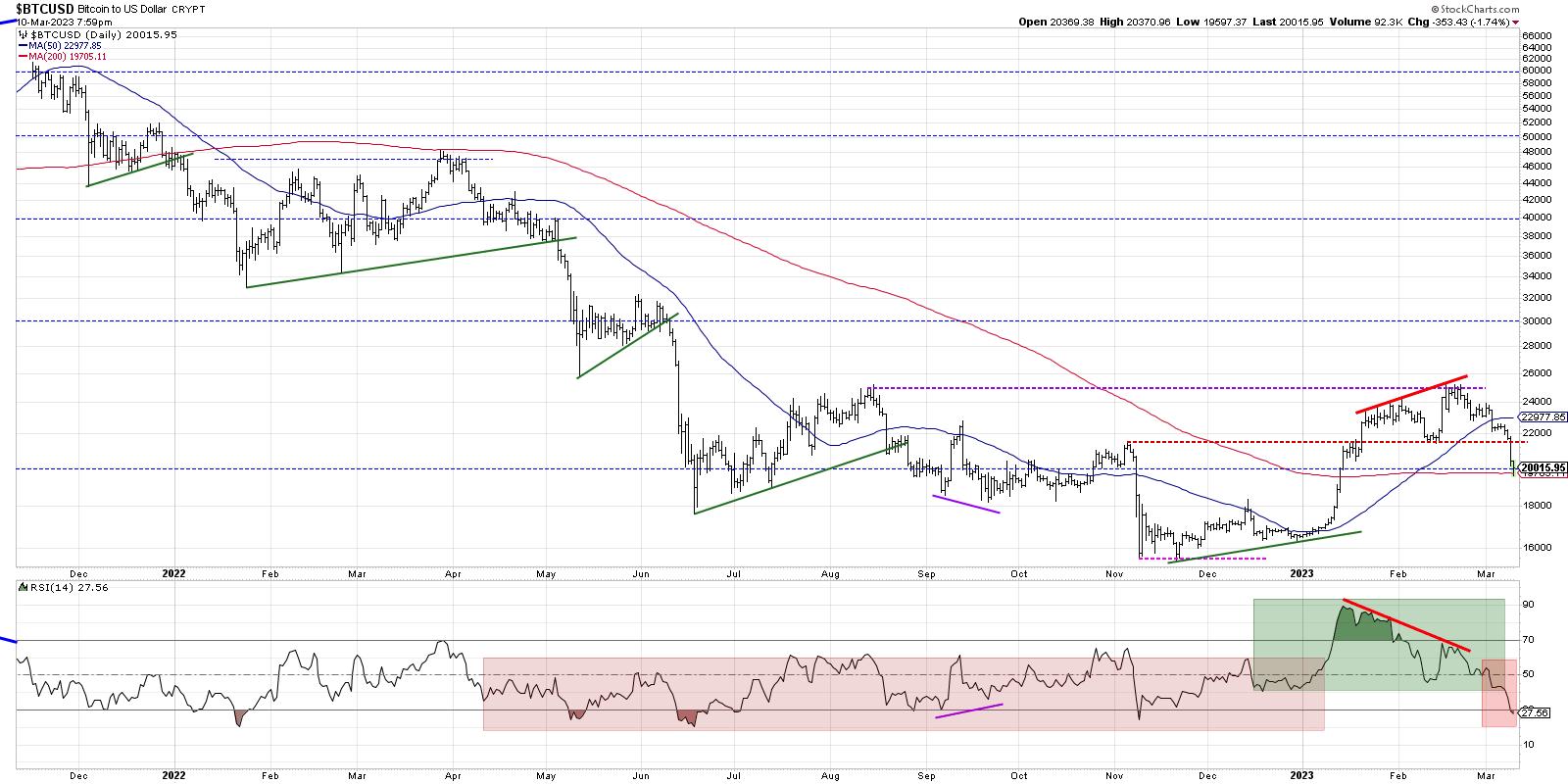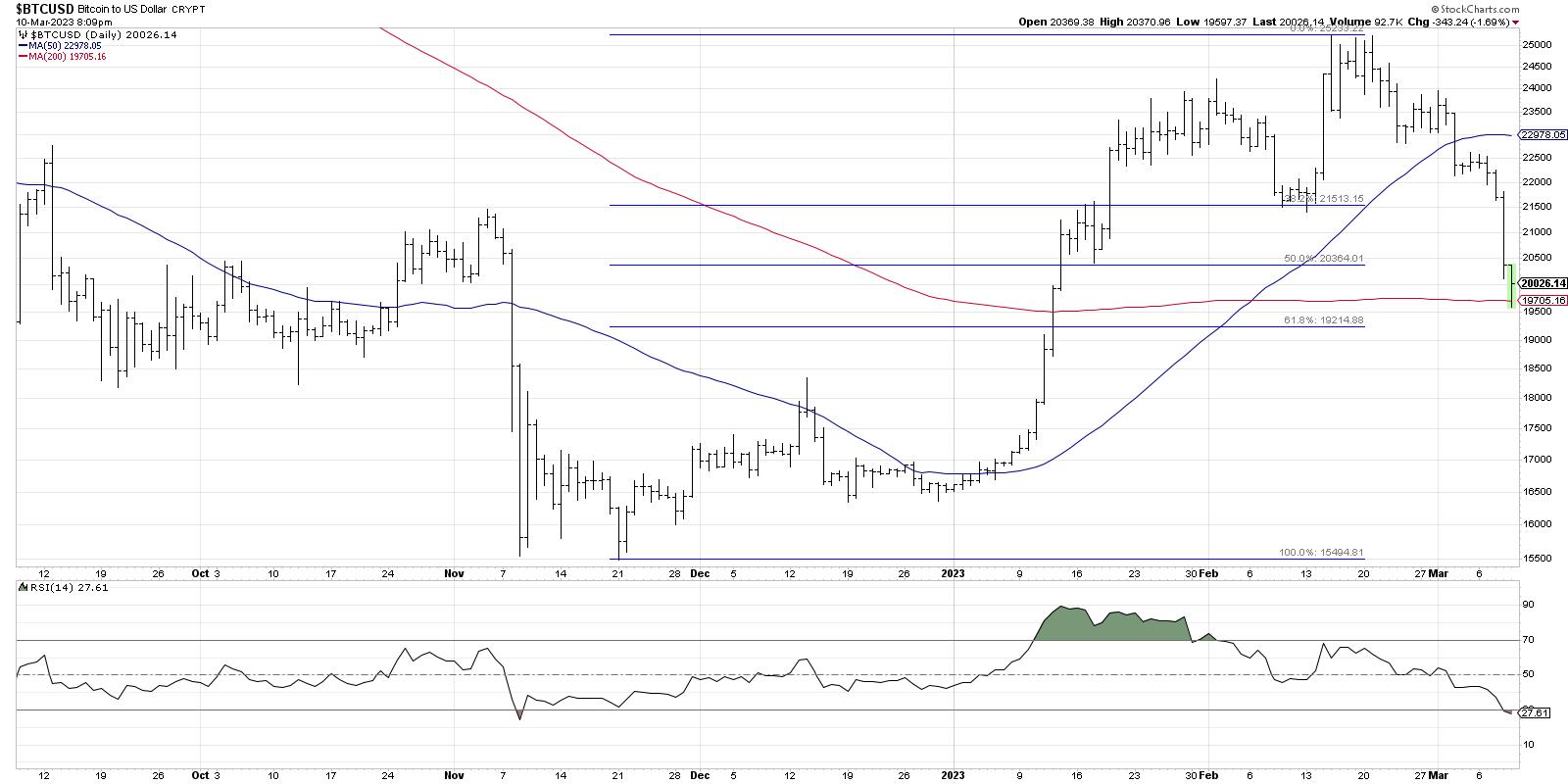I'm a big fan of playing the long game as an investor, particularly for long-term accounts that should arguably not be affected by short-term market fluctuations. Talking with experts like Jon Markman, author of Fast Forward Investing, has reminded me that overarching themes like artificial intelligence, electric vehicles, and digital assets are long-term plays.
While the benefits of these technologies are clear, the path between now and some future state are somewhat less clear. It seems obvious to me that blockchain technology is transformative, and it will certainly impact our lives in ways we have not yet imagined.
For now, however, cryptocurrencies have rotated lower in a sudden and powerful way, giving a very "risk off" feel to this area of the financial markets. What downside targets make sense for Bitcoin which could present opportunities for a lower entry point?
Bearish Evidence, Three Ways
First, let's review how the chart rotated from a clear accumulation phase to a distribution phase. Momentum divergences, where the price and RSI go from moving in tandem to moving in opposite directions, are one of my favorite leading indicators to anticipate a trend reversal.

Note the higher highs in price from January to February, with Bitcoin testing the August 2022 high around 25,000. Now look at how the RSI was extremely overbought at the January high (almost reaching 90!) versus below the overbought threshold at the February swing high. This weakening of momentum suggested that the buying power was dissipating and a downside corrective move was imminent.
This week, we can see Bitcoin failing to hold its most recent swing low around 21,500. This lined up beautifully with the November swing high, and, if Bitcoin had held this level, it would have indicated a likely end to the short-term correction. However, we can see that level was violated to the downside, pushing Bitcoin down to test its 200-day moving average around 20,000. So now we are testing not just moving average support, but also a "big round number" which has often served as support and resistance for Bitcoin.
Finally, we see the RSI failing to hold the crucial 40 level, now pushing into oversold territory below 30. When the entire range of the RSI moves lower, and selloffs reached the oversold level, this is more characteristic of bear market phases than bull market phases.
Identifying Downside Targets
So how do we anticipate downside price objectives after key support has been broken?
First, we need to focus in on the next level of support. In my opinion, we are sitting at the crucial "line in the sand" of 20,000. If and when we break this key area of support, we need to start looking for additional downside targets.

When you zoom into the last six months or so, we can see some short-term Fibonacci levels that may be important in the coming days and weeks. The bad news for Bitcoin is we've already broken down through the first two objectives, which suggests that 19,200 could be considered the "point of no return" for the bull case. If we break that level, it will likely continue down to the November 2022 lows of around 15,500-16,000.
It's worth noting here that, while I often identify specific price levels based on support and resistance or Fibonacci levels, I usually think of support and resistance more in ranges than specific levels.
When the modern technical toolkit was being refined in the 20th century, stocks were traded on 1/8 increments, so it was pretty reasonable that a stock would reach a specific level and then turn on a dime. That was because there were only eight levels between each dollar! In the modern era of decimalization, dark pools, and high-frequency trading, the expectation that prices would find support or resistance at a precise level seems disconnected from the reality of the financial markets!
What's Next for Bitcoin?
With any investment approach, separating the long-term thesis from the short-term story is important. I had great conversations with people like Adrien Zduńczyk on the long-term potential for blockchain and digital assets. I still believe very much in the long-term thesis here.
But my recent analysis of the daily chart of Bitcoin tells me that the upswing off the 2022 low has transitioned from "called into question" into more of a "definitely going down" sort of feel. And, unless Bitcoin can hold its 200-day moving average, it appears that we may be retesting the 2022 lows again.
The good news is that if your runway is long enough, this may present a fantastic opportunity to add exposure to a strong long-term story undergoing a cyclical weakness.
Want to see analysis of the recent breakdown of Bitcoin in video format? Head over to my YouTube channel!
RR#6,
Dave
P.S. Ready to upgrade your investment process? Check out my free behavioral investing course!
David Keller, CMT
Chief Market Strategist
StockCharts.com
Disclaimer: This blog is for educational purposes only and should not be construed as financial advice. The ideas and strategies should never be used without first assessing your own personal and financial situation, or without consulting a financial professional.
The author does not have a position in mentioned securities at the time of publication. Any opinions expressed herein are solely those of the author and do not in any way represent the views or opinions of any other person or entity.






